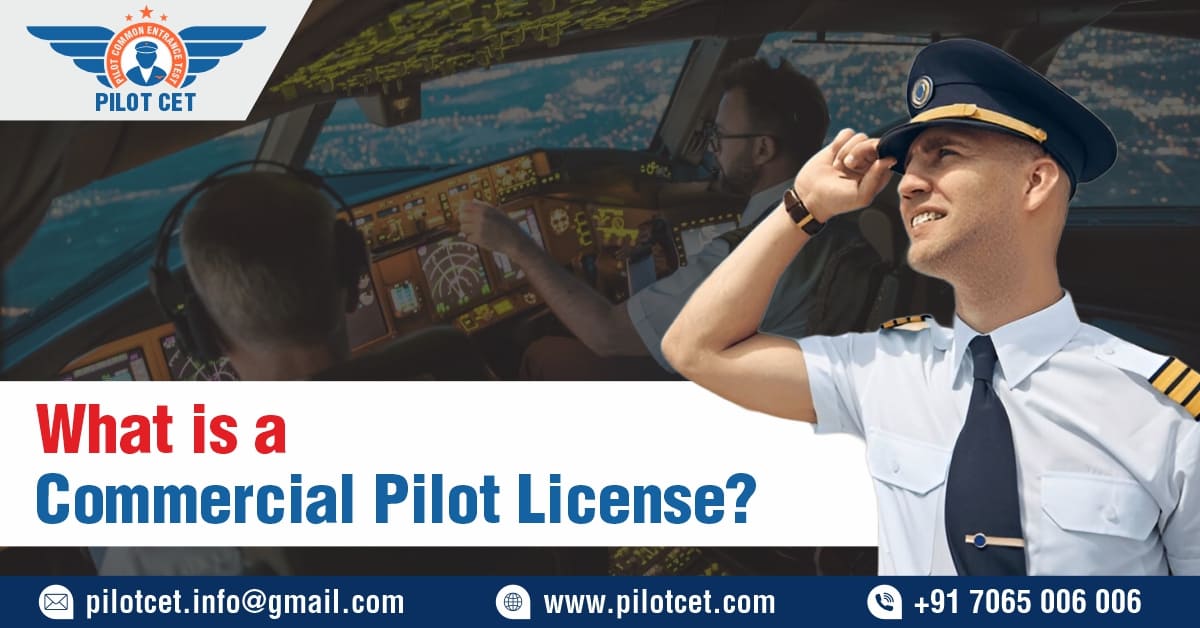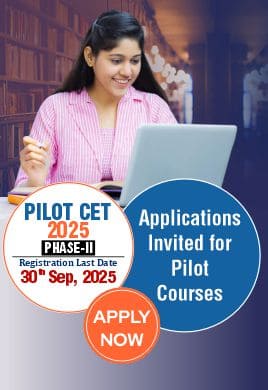
what is a commercial pilot license?
CPL is a profession license which give authority to commercial pilots to carry the passengers and fly the aircrafts. CPL holders operate aircraft for commercial use such as airlines, cargo services, charter flights and corporate aviation etc. In contrast to a PPL that requires performing only personal flying CPL turns aviation into a profession. CPL in India is authorized & regulated by the (DGCA). It makes sure that the pilots meet all safety, medical and training standards required to fly commercially. CPL is the key to the successful aviation career as it leads to a better career as a First Officer and Captain & provide opportunities all over the world, prestige and high goods income. There are two types of CPL:
- CPL (A) - Aeroplanes: Allows the holder to operate fixed-wing aircraft commercially.
- CPL (H) - Helicopters: Allows the holder to operate helicopters commercially.
Who Can Apply?
DGCA has established some requirements of obtaining a Commercial Pilot License in India. These requirements makes sure that the future pilots have the right educational background, medical fitness, flying experience etc. The table below summarizes the key eligibility factors for obtaining a CPL in India.
|
Eligibility Factor |
Requirement |
|
Age |
Minimum 18 years at the time of CPL issuance |
|
Educational Qualification |
10+2 with PCM from a recognized board or equivalent |
|
DGCA Ground Modules |
Must complete all DGCA theoretical subjects including Air Regulations, Aviation Meteorology, Air Navigation, Aircraft Technical/ Specific and RTR |
|
Flying Training |
Minimum 200 hours of flying experience including dual and solo flights |
|
Type Rating |
CPL aspirants must complete type rating training for specific aircraft to qualify for commercial operations |
|
Medical Fitness |
Must clear DGCA Class 1 Medical examination (vision, hearing, general health and psychological assessment) |
|
Language Proficiency |
Good knowledge of English for communication with ATC, crew and aviation operations |
Course Duration & Fees
If you are planning to become a commercial pilot then it is very important to know the time taken and cost of the course. This makes it easier for all students to plan the future investments & pursue their dream of flying globally.
|
Category |
Details |
|
Duration |
18-24 months |
|
Fees |
INR 45-55 lakhs approx. |
|
Financial Help |
Scholarships and student loans available for students |
How to apply for the course?
Students can appear for entrance exams like Pilot CET or AME CET to get admission to top flying schools in India.
- These exams evaluates the knowledge in subjects like Physics, Mathematics and basic aptitude etc.
- These exams helps students to decide if they are ready for pilot training before investing in the course.
- These entrance exams also provide often scholarships which help reducing the financial burden of CPL training.
- Provides career guidance and provide admission reputed DGCA-approved flying training institutes.
Start Ground Classes (Theory)
After admission students first have to attend the 800 hours of CPL ground classes which is commom for CPL-(A) & CPL-(H).It covers the study of six key modules of pilot training which is very important as it provides the knowledge needed for safe and efficient flying.
|
Module |
Explanation |
|
Air Regulations |
Covers aviation laws, rules and procedures set by DGCA and ICAO for safe flying. |
|
Aviation Meteorology |
Teaches weather patterns, clouds and their effects on flight operations. |
|
Air Navigation |
Focuses on map reading, flight planning and navigating aircraft safely. |
|
Technical General |
Explains basic aircraft systems, engines and performance principles. |
|
Technical Specific |
Provides detailed knowledge of the specific aircraft you'll operate. |
|
RTR |
Trains you in radio communication with ATC and ground stations. |
Flying Training (Practical)
After completing flying student start their practice flying training which is a very crucial part of the training where students get real life experience of flying an aircraft. Flying hours for CPL-(A) and CPL-(H) are different and are given below:
|
Flying Component |
CPL-(A) Aeroplanes |
CPL-(H) Helicopters |
|
Total Hours |
200 hrs minimum |
150 hrs minimum |
|
Solo |
100 hrs |
70-80 hrs |
|
Dual |
40-50 hrs |
40-50 hrs |
|
Cross-Country |
20 hrs |
10-15 hrs |
|
Night |
5 hrs |
5 hrs |
|
Instrument |
10 hrs |
5-10 hrs |
|
Practice / Check |
Remaining to total 200 hrs |
Remaining to total 150 hrs |
|
Training Aircraft |
Cessna 172S, Cessna 152, other small planes |
Robinson R44, Bell 206, other training helicopters |
Exams & Licensing
After completing the commercial pilot license training students have to pass the DGCA examinations and flying test to get their pilot license. This process includes written exams, practical flying test with a certified examiner and verification of medical fitness. A successful completion will make the student eligible to become an aircraft Pilot-in-Command (PIC) operating within the DGCA regulations.
|
Stage |
Description |
|
Written Exams |
Conducted by DGCA on ground modules: Air Regulations, Meteorology, Air Navigation, Aircraft Technical (General and Specific) and RTR. Tests theoretical knowledge. |
|
Flying Test |
Practical assessment by a DGCA-certified examiner covering takeoffs, landings, solo flying, cross-country navigation and basic instrument flying. |
|
Licence Issuance |
After passing written exams, flying test and holding a valid DGCA medical certificate, DGCA issues the PPL license allowing the holder to fly as Pilot-in-Command (PIC |
Jobs & Salary
CPL is a gateway to an exciting and rewarding career. The following table shows the potential salary and job profiles of CPL holders and what you will get in this high flying career:
|
Job Profile |
Salary in India (INR/Month) |
International Salary (USD/Month) |
|
Commercial Pilot (Fresh CPL Holder) |
INR 1,50,000 - 3,00,000 |
USD 3,000 - 6,000 |
|
First Officer (Co-Pilot) |
INR 3,00,000 - 5,00,000 |
USD 6,000 - 9,000 |
|
Captain (After Experience) |
INR 6,00,000 - 10,00,000 |
USD 10,000 - 18,000 |
|
Charter Pilot |
INR 2,00,000 - 4,00,000 |
USD 4,000 - 7,000 |
|
Cargo Pilot |
INR 3,00,000 - 6,00,000 |
USD 6,000 - 10,000 |
|
Flight Instructor |
INR 1,50,000 - 2,50,000 |
USD 3,000 - 6,000 |
|
Corporate Jet Pilot |
INR 3,00,000 - 6,00,000 |
USD 6,000 - 10,000 |
|
Helicopter Pilot |
INR 2,00,000 - 4,00,000 |
USD 4,000 - 8,000 |
Expert Tips for Aspiring Pilots
- Stay Disciplined and Confident: Consistency and self-belief are crucial in both theory and flying training. A disciplined routine builds strong habits.
- Practice Theory and Flying Regularly: Regular study of aviation subjects and hands-on flying practice helps you retain knowledge and improve skills.
- Never Skip Flight Hours or Medical Checks: Completing all mandatory flying hours and staying medically fit are essential to meet DGCA requirements.
- Maintain Physical Fitness: A healthy body supports alertness, endurance, and overall performance during long flights and training sessions.
- Develop Strong Communication Skills: Clear communication with air traffic control, instructors, and crew ensures safety and efficiency.
- Stay Calm Under Pressure: Emergencies are part of aviation; learning to stay composed improves decision-making and safety.
- Take Mock Tests and Simulator Sessions Seriously: Simulated scenarios help prepare for real-world situations without risk.
- Seek Guidance from Experts: Learn from instructors, senior pilots, and mentors to gain practical tips and insights.
- Be Organized: Maintain flight logs, study materials, and schedules accurately to track your progress and stay on top of training.
- Stay Motivated and Patient: Pilot training can be challenging and time-consuming, but perseverance leads to a rewarding aviation career.
Commercial pilot license is a key for a successful global flying career. Students from any stream can pursue CPL as a career though they just need to fulfill some requirements to start. After gaining CPL students can enjoy the best white collar job opportunities globally within aviation sector. CPL holders can start as co-pilots then advance to captain and access high-paying domestic and international jobs. With dedication, discipline and consistent practice, students can master in their dream flying career.
Frequently Asked Questions
A commercial pilot license lets you fly aircraft for pay. Anyone who meets age education medical and flying criteria can get it.
read more..
Yes, what is a commercial pilot license is required if you want to fly for airlines cargo charter or other commercial services.
read more..
What is a commercial pilot license cost is about INR 35–55 lakhs for full training in India.
read more..
The what is a commercial pilot license needs minimum 200 flying hours (dual solo cross country).
read more..
The what is a commercial pilot license involves DGCA exams + a flying test + medical checks
read more..
The what is a commercial pilot license lets you fly commercially PPL is just for private use.
read more..
The what is a commercial pilot license opens roles in airlines charter services cargo and more.
read more..
The what is a commercial pilot license also exists for helicopters (CPL-H) to fly rotorcraft commercially.
read more..
Commercial Pilot License Commercial Helicopter Pilot License Private Pilot License Private Helicopter Pilot License

